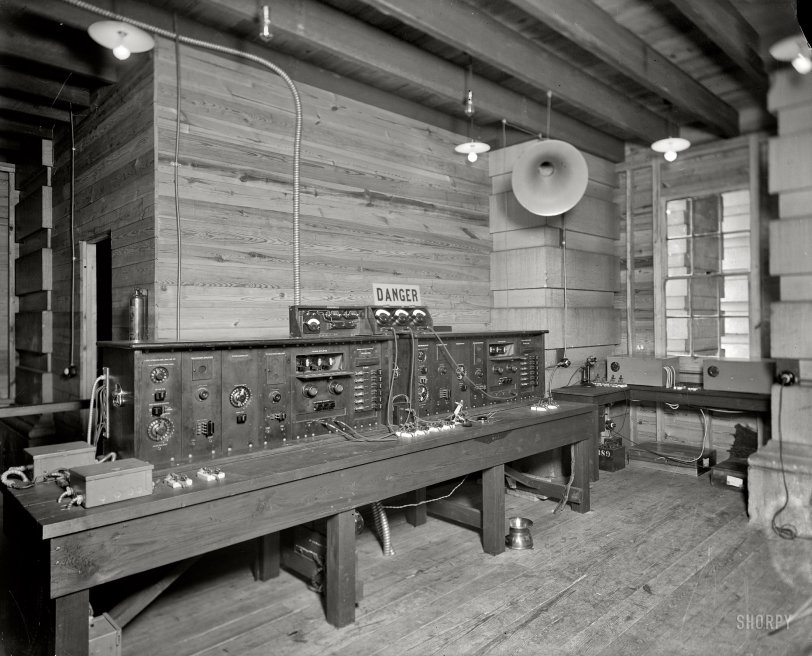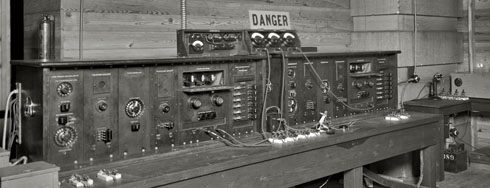


Framed or unframed, desk size to sofa size, printed by us in Arizona and Alabama since 2007. Explore now.
Shorpy is funded by you. Patreon contributors get an ad-free experience.
Learn more.

- Freeze Frame
- Texas Flyer wanted
- Just a Year Too Soon
- WWII -- Replacing men with women at the railroad crossing.
- Yes, Icing
- You kids drive me nuts!
- NOT An Easy Job
- I wonder
- Just add window boxes
- Icing Platform?
- Indiana Harbor Belt abides
- Freezing haze
- Corrections (for those who care)
- C&NW at Nelson
- Fallen Flags
- A dangerous job made worse
- Water Stop
- Passenger trains have right of way over freights?
- Coal
- Never ceases to amaze me.
- Still chuggin' (in model form)
- Great shot
- Westerly Breeze
- For the men, a trapeze
- Tickled
- Sense of loneliness ...
- 2 cents
- Charm City
- What an Outrage
- Brighton Park
Print Emporium
Dial D for Danger: 1919

Washington, D.C., circa 1919. "Chesapeake & Potomac Telephone Co. equipment." Harris & Ewing Collection glass negative. View full size.
Modularized
Interesting to see the modularization of that panel so early in the game. Very logical. Each module with a tube inside has associated jacks so that a meter box can be used to quickly check operating conditions.
The PA idea makes sense considering the connections for "long line" and "phonograph." Four tubes that size might realize a 1000-watt system.
Public Address System
That appears to be an old public address system with the capability to attach and simulcast over the "long lines" of the phone system. "Loud Speaking Receivers" would be bullhorns. Both consoles are nearly identical. Each console has four tubes with inputs to drive 1&2 and 3&4 separately.
This appears to be a system operator position, and not the position one would speak from. A microphone and a headset earpiece are between the consoles and are connected to the small box between them, not to either console. If I'm right, then the mic and headset would be to coordinate with the other half of this contraption -- probably near the speaker position and/or the other side of that "phonograph circuit."
Phonograph circuit
So why is there a "Phonograph cct"?
Danger: Yes!
Watch out for the carbon tetrachloride fire extinguisher; it's poisonous.
Knife switches and quarter-inch jacks
I'm just amazed at the number of porcelain-based knife switches that were used in the operation of the equipment. In looking closer you can see quarter-inch jack plugs, commonly called "phone" jacks. Which went on to become the standard for broadcast patch panels and guitar amplifiers and cables.
The vacuum tubes
in the amplifiers probably had 700 volts on their plate circuits.
My father's first ham (amateur radio) license was issued to him in 1919 and I remember components in our home that looked similar to those pictured.
Details, details
The latest equipment
Of course it wouldn't be complete without a cuspidor.
Essential equipment
A fire extinguisher, and what seems to be a cuspidor. Furniture by Flintstone and Rubble.
Under the Capitol?
Looks like a temp facility in the same general location as this..
https://www.shorpy.com/node/5384
Maybe under the East Front? The columns give it away..
Pre-miniaturization!
Fascinating glimpse onto transitional technology. I wonder if a higher resolution scan would allow the label to be read and some of the functions determined?
Lots of selector switches, several knife switches (looking like telegraph keys), some mics and one big honking speaker. And some lovely woodwork!

























On Shorpy:
Today’s Top 5